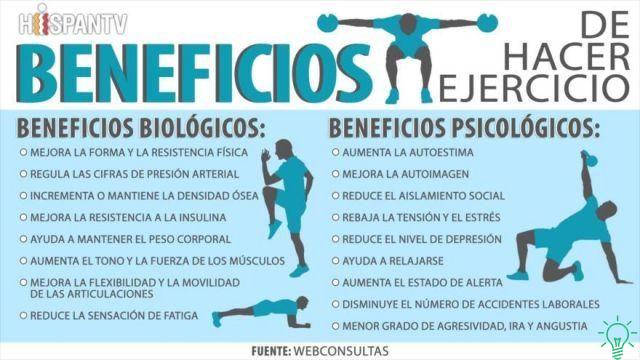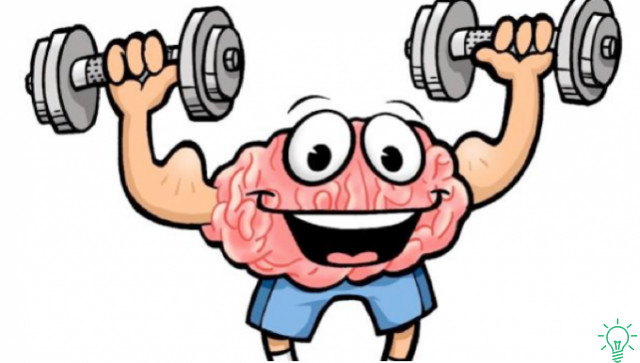
How to improve physical resistance (increasing health, sports and sexual performance) and psychological resistance (to withstand stressful situations).
Today's society is constantly evolving and imposes ever higher levels of physical and mental performance. To support these workloads, it is advisable to improve physical and mental resistance, without forgetting that the two skills are closely related.
So, let's find out together how to improve / increase psychophysical resistance to get the most out of life.
Tabla de contenido
- What is resistance?
- How to improve physical endurance
- 10 Tips to Improve Psychological Resilience
What is resistance?
Endurance is defined as "the ability to withstand prolonged physical or mental exertion," according to the Oxford Dictionary.
In practical terms, it means that a good resistance allows you to:
- Run faster for longer distances
- Lift heavier weights for more reps
- Take longer, more difficult hikes.
- Continue and not give in to perceived pain, discomfort, and tiredness
- Perform daily activities with high energy levels.
The better your stamina, the more efficient you'll become at just about everything, mentally and physically. In fact we can speak of "psychophysical resistance", in the same way that we speak of "psychophysical health".
How to improve physical endurance
In this section of the article we will provide you with a series of simple fitness tips to increase your resistance Physics
If you had to choose one and only one component of fitness to improve, which one would you choose? You are probably thinking that you would try to improve your strength, duration or speed, which are all valid goals to pursue.
However, there is one less appreciated factor that actually combines several fitness components into one: endurance. If you want to get the most out of your physical training, consider exercising to improve your physical endurance.
The components of physical resistance.
Resistance and Duration
People often use the words "strength" and "durability" interchangeably, and while the two terms are similar, they are not the same. Endurance is defined as “the ability to resist a difficult process or situation without giving up,” and there are two types of endurance related to fitness: cardiovascular endurance and muscular endurance.
Cardiovascular endurance refers to the ability of the heart, lungs, and blood vessels to withstand continuous, rhythmic exercise such as swimming, cycling, and running.
Muscular endurance refers to the ability of muscles to sustain repetitive movements under a certain load, such as when lifting weights or walking.
Both types of endurance are important, and both represent a component of overall physical endurance.
Resistance and Strength
Strength has many different definitions, but when it comes to fitness, it essentially defines how much weight you can lift.
People who are very strong can lift heavier weights and can also lift lighter weights for many reps. People with less strength lift fewer weights and may not be able to do as many reps.
Strength training contributes to your endurance because it conditions your body to withstand movement under heavy loads.
Improving your strength also helps with endurance exercises, because the stronger and better developed your muscles are, the more effectively they can handle repetitive movements.
Endurance and Speed
Speed, as you probably know, refers to how fast or slow you move when walking, running, swimming, or doing other cardio exercises. Genes in your DNA can affect speed more than they affect strength and endurance, though you can improve speed with hard work just like you can improve any other component of your fitness.
Endurance is primarily based on durability and strength, because the definition refers to the ability to sustain a given effort.
The stronger you are, the more effort you can make. The better the resistance, the longer you can sustain a certain effort. So speed has little effect on stamina, but still plays a big role in your overall fitness.
How to improve your physical resistance
The key concept is to challenge yourself. If you're looking to improve your endurance (or any aspect of your fitness), you'll need to follow the "progressive overload principle," a physiological rule of how the body gets stronger, faster, and fitter.
Simply put, the principle of progressive overload says that you will not improve in any capacity if you continue to do the same workouts at the same intensity over and over again.
You have to change something, be it frequency, intensity, volume, weight, distance, speed or rest intervals.
For example, if you can barbell squat 10 reps with 80kg, you should try doing 12 reps with 80kg or 10 reps with 85kg. Small increments like this lead to significant improvements over time.
Here are 16 ways to change up your exercise routine and induce improvements in your endurance.
take long walks
Here's an easy way to improve your endurance: simply move your body for long periods of time. Taking long walks of 30 to 60 minutes is a great way to build endurance, especially for beginners. Even the most experienced can enjoy the endurance-boosting effects of long-distance walking by increasing the speed and intensity.
Add race intervals
If you think walking isn't enough to improve your endurance, try incorporating some running intervals into your walk. Interval training has been shown to be one of the best ways to improve overall fitness. The next time you go for a walk, add a 30-second sprint every three to four minutes.
Increase race distance or time
Since endurance is a combination of durability, speed, and strength, challenge yourself to maintain your normal running pace for another minute. When you manage to do this, add another minute. Your stamina should continue to improve this way for a while at least, though everyone has limits on how far and how fast they can run.
Running hills and stairs
If increasing your race distance or time doesn't sound like fun (we don't blame you), change your race type.
If you live near hills or hiking trails, adding hill running to your routine can make a big difference in your endurance.
Alternatively, stairs and bleachers work too. Running uphill puts both the lungs and the legs to the test.
Try high-volume weightlifting
Studies show that volume is the number one variable in resistance training that improves fitness. Volume refers to the total load you lift in a given session, day, or week. It is calculated by multiplying the weight by the repetitions.
For example, if you perform three sets of 10 squats with 80 kg, your total volume is obtained by multiplying 10 by 100. The total volume is then 800 kg. In general, continually increasing your training volume benefits your fitness and endurance.
Practicing isometric exercises
Isometric exercise refers to any exercise during which the muscles must maintain a static position, neither extending nor contracting. Planks and wall sits are two good examples of isometric exercises. Incorporating isometric work into your exercise routine trains your muscles to hold a stressed position for longer periods of time.
Decrease rest intervals during workouts
A surefire way to improve your endurance is to give yourself less rest time (unless you're lifting very heavy weights, in which case you should rest three to five minutes between sets for optimal strength gains).
Studies show that decreasing rest intervals while engaging in moderate- or high-intensity exercise increases physical performance and body composition.
Shortening your rest interval forces you to do more work in less time, which in theory should help improve endurance.
try cycling
Cycling in any form—mountain biking, road biking, or indoor cycling—can improve your endurance if you keep up a good pace.
Indoor cycling, in particular, has been shown to increase aerobic capacity, an important factor for endurance, as well as other indicators of health.
Mountain biking may be more effective at increasing muscular endurance and power due to the variability of the trail.
Swap cycling for rowing
If you're already an avid cyclist, you may want to add rowing to your exercise rotation. Scientists have long speculated that rowing is a more effective exercise than cycling because it recruits more muscle groups with greater intensity. Rowing seems to improve cardiovascular fitness more than riding a bike, so the next time you get a chance to get in a canoe, go for it!
dance
Dancing is a great way to exercise that will burn your lungs and muscles, and it's fun! Dancing can also prompt you to practice new positions and movements, improving your body structure.
Various scientific studies have shown that dance has a significant impact on health and fitness, from improving mobility and balance to improving cardiovascular endurance.
have more sex
Fitness doesn't always have to be so structured. Other activities, like sex, can also improve your physical stamina. Intercourse can be extremely physically intense and as such can improve cardiovascular health and muscular endurance.
Surprisingly, scientists conducted research on this: As early as 1981, researchers speculated that sexual activity could improve physical performance. And in 2010, researchers concluded that intercourse carries several physiological health benefits, including pain-relieving properties, that could help you get through the toughest of workouts. At the very least, having sex won't negatively affect your physical performance, as is commonly believed.
Feel free to take this advice as reason enough to replace a workout with some time in the bedroom.
Play team sports
Again, deconstructing your exercise routine could, albeit counterintuitively, improve your endurance and fitness. Most sports require complex skills that may be outside of your comfort zone. If you're used to lifting weights, running, or other relatively monotonous movements, swapping one workout each week for a team sport is a great way to hone other physical skills.
For example, a game of soccer includes running, jogging, walking, kicking, dodging, and even throwing, depending on the position you play. Combining these different moves provides a fun and challenging way to improve your endurance.
Listen to music while you exercise.
Everyone knows that a good song can encourage you to exercise. Listening to music brings joy and energy to people, and this is maintained throughout the exercise. Listening to upbeat music while you exercise can improve your performance in several ways by reducing your perception of fatigue, distracting you from workout fatigue, and making exercise feel easier.
Drink caffeine before exercising
If you're looking for a unique way to improve your endurance, consuming a little caffeine before your workout might help. Studies show that caffeine acts as an excellent pre-workout supplement, as it can increase energy, mood, and physical abilities, although the effect appears to be more significant in men than women, and should be taken Be careful not to get addicted. caffeine.
To meditate
Remember how we said that the word "endurance" refers to both physical and mental activities? This is where meditation comes in. Adding mindfulness practices like meditation, deep breathing, or yoga to your overall wellness routine could improve your mental toughness.
If you're used to fast, engaging workouts, mindfulness practices will challenge you to overcome perceived boredom and manage stress, two factors that play a big role in both physical and psychological endurance. In fact, a 2016 study in the journal Evidence-Based Complementary and Alternative Medicine found that medical students reported better mental toughness (less stress and better patience and well-being) after six weeks of yoga and meditation.
Don't forget to rest and recover.
Finally, make sure you have recovery days planned into your training routine. Contrary to popular belief, it is not the act of training itself that improves fitness, but rather the repair and rebuild phase that does. If you do an intense workout every day, your body will never have a chance to recover, so it will never have a chance to repair your muscles. Rest days are critical to your improvement over time.
How to improve psychological resistance
Here are 10 tips to improve psychological resilience, better tolerating stress and life's challenges.
- create ties. It is important to have good relationships with close family, friends, or other loved ones. Accepting help and support from those who care about you and listen to you builds resilience. Some people argue that being active in civic groups, religious organizations, or other local groups provides them with social support and helps restore hope when it fails. Helping others in times of need can benefit those who help.
- Avoid seeing crises as insurmountable problems. Highly stressful events happen and there is nothing you can do to prevent them, but you can change the way you interpret and respond to these events. Try to project yourself beyond the present to see how future circumstances can be better in the future. Take advantage of every opportunity and every thought that can make you feel better in difficult situations.
- Accept that change is part of life.. Some of your goals may no longer be attainable due to adverse situations. Accepting circumstances that cannot be changed can help you focus on what you can influence.
- Move towards your goals. Develop realistic goals and regularly do something, even if it seems like a small accomplishment, that moves you toward your goals. Instead of focusing on tasks that seem unattainable, ask yourself, "What is something I know I can accomplish today that helps me move in the direction I want to go?"
- take decisive action. Act on adverse situations as quickly as possible. Practice recovery strategies, instead of completely detaching yourself from problems and stress and wishing they would go away.
- discover your strength. People often learn something about themselves when they struggle to get over a difficulty or a loss. Many people who have experienced tragedy and hardship are able to build stronger relationships and maintain a self-awareness of their strength even when they feel (or are) vulnerable. Overcoming great difficulties provides a greater sense of self-esteem, a more developed spirituality, and a greater appreciation of your life.
- Cultivate a positive view of yourself. Developing confidence in one's ability to solve problems and trusting one's instincts helps build resilience.
- see things in perspective. Even when facing very painful events, try to consider the stressful situation in a larger context and keep a long-term perspective. Avoid exaggerating the event. Never lose hope.
- so optimistic. Seeing reality through the lens of positivity allows you to better face life's challenges and never stop fighting for what you believe in. Try to visualize what you want, instead of worrying about what you fear.
- Beware. Pay attention to your needs and feelings. Participate in activities that you enjoy and find relaxing. Exercise regularly (as we suggested above). Taking care of yourself helps keep your mind and body prepared for situations that require resilience.
They may be interested in:
- How to improve memory: 14 natural ways
- 12 exercises to improve posture
- How To Dramatically Improve Your Communication Skills In 5 Minutes
- The psychological benefits of sport
- How to improve sexual performance: 9 tips
- How to improve a couple's sex life
























